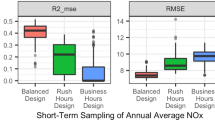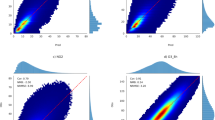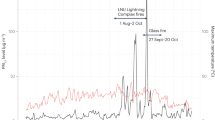Abstract
In epidemiologic studies of health effects of air pollution, measurements or models are used to estimate exposure. Exposure estimates have errors that propagate to effect estimates in exposure-response models. We critically evaluate how types of exposure measurement error influenced bias and precision of effect estimates to understand conditions affecting interpretation of exposure-response models for epidemiologic studies of exposure to PM2.5, NO2, and SO2. We reviewed available literature on exposure measurement error for time-series and long-term exposure epidemiology studies. For time-series studies, time–activity error (daily exposure concentration did not account for variation in exposure due to time–activity during a day) and nonambient (indoor) sources negatively biased the effect estimates and increased standard error, so uncertainty grew with increasing bias while underestimating the true health effect in these studies. Spatial error (deviation between true exposure concentration at an individual’s location and concentration at a receptor) was ascribed to negatively biased effect estimates in most cases. Positive bias occurred for spatially variable pollutants when the variance of error correlated with the exposure estimate. For long-term exposure studies, most spatial errors did not bias the effect estimate. For both time-series and long-term exposure studies reviewed, large uncertainties were observed when exposure concentration was modeled with low spatial and temporal resolution for a spatially variable pollutant.
This is a preview of subscription content, access via your institution
Access options
Subscribe to this journal
Receive 6 print issues and online access
$259.00 per year
only $43.17 per issue
Buy this article
- Purchase on Springer Link
- Instant access to full article PDF
Prices may be subject to local taxes which are calculated during checkout



Similar content being viewed by others
References
Clean Air Act, as amended by Pub. L. No. 101–549 (1990).
U.S. EPA. Integrated science assessment for particulate matter. EPA Report. EPA/600/R-08/139F. Research Triangle Park, NC: U.S. Environmental Protection Agency, Office of Research and Development, National Center for Environmental Assessment- RTP Division, 2009.
EPA U.S. Integrated science assessment for oxides of nitrogen (final report). EPA Report. EPA/600/R-15/068. Research Triangle Park, NC: U.S. Environmental Protection Agency, National Center for Environmental Assessment, 2016.
U.S. EPA. Integrated science assessment for sulfur oxides: Health criteria. EPA Report. EPA/600/R-17/451. Research Triangle Park, NC: U.S. Environmental Protection Agency, Office of Research and Development, National Center for Environmental Assessment-RTP, 2017.
EPA U.S. Preamble to the Integrated Science Assessments. EPA Report. EPA/600/R-15/067. Research Triangle Park, NC: National Center for EnvironmentalAssessment, Office of Research and Development, 2015.
Lipfert FW, Wyzga RE. The effects of exposure error on environmental epidemiology. In Proceedings of the 2nd Colloquium on Particulate Air Pollution and Health, Park City, UT, 1996.
Armstrong BK, White E, Saracci R. Principles of exposure measurement in epidemiology. New York, NY: Oxford Univ. Press; 1992.
Szpiro AA, Paciorek CJ, Sheppard L. Does more accurate exposure prediction necessarily improve health effect estimates? Epidemiology. 2011;22:680–5.
Goldman GT, Mulholland JA, Russell AG, Strickland MJ, Klein M, Waller LA, et al. Impact of exposure measurement error in air pollution epidemiology: effect of error type in time-series studies. Environ Health. 2011;10:61.
Reeves GK, Cox DR, Darby SC, Whitley E. Some aspects of measurement error in explanatory variables for continuous and binary regression models. Stat Med. 1998;17:2157–77.
Basagaña X, Aguilera I, Rivera M, Agis D, Foraster M, Marrugat J, et al. Measurement error in epidemiologic studies of air pollution based on land-use regression models. Am J Epidemiol. 2013;178:1342–6.
Goldman GT, Mulholland JA, Russell AG, Srivastava A, Strickland MJ, Klein M, et al. Ambient air pollutant measurement error: characterization and impacts in a time-series epidemiologic study in Atlanta. Environ Sci Technol. 2010;44:7692–8.
Goldman GT, Mulholland JA, Russell AG, Gass K, Strickland MJ, Tolbert PE. Characterization of ambient air pollution measurement error in a time-series health study using a geostatistical simulation approach. Atmos Environ. 2012;57:101–8.
Strickland MJ, Gass KM, Goldman GT, Mulholland JA. Effects of ambient air pollution measurement error on health effect estimates in time-series studies: a simulation-based analysis. J Expo Sci Environ Epidemiol. 2013;25:160–6.
Dionisio KL, Baxter LK, Chang HH. An empirical assessment of exposure measurement error and effect attenuation in bipollutant epidemiologic models. Environ Health Perspect. 2014;122:1216–24.
Sheppard L, Slaughter JC, Schildcrout J, Liu JS, Lumley T. Exposure and measurement contributions to estimates of acute air pollution effects. J Expo Anal Environ Epidemiol. 2005;15:366–76.
Butland BK, Armstrong B, Atkinson RW, Wilkinson P, Heal MR, Doherty RM, et al. Measurement error in time-series analysis: a simulation study comparing modelled and monitored data. BMC Med Res Methodol. 2013;13:136.
Alexeeff SE, Schwartz J, Kloog I, Chudnovsky A, Koutrakis P, Coull BA. Consequences of kriging and land use regression for PM2.5 predictions in epidemiologic analyses: insights into spatial variability using high-resolution satellite data. J Expo Sci Environ Epidemiol. 2015;25:138–44.
Gryparis A, Paciorek CJ, Zeka A, Schwartz J, Coull BA. Measurement error caused by spatial misalignment in environmental epidemiology. Biostatistics. 2009;10:258–74.
Setton E, Marshall JD, Brauer M, Lundquist KR, Hystad P, Keller P, et al. The impact of daily mobility on exposure to traffic-related air pollution and health effect estimates. J Expo Sci Environ Epidemiol. 2011;21:42–8.
Szpiro AA, Paciorek CJ. Measurement error in two-stage analyses, with application to air pollution epidemiology. Environmetrics. 2013;24:501–17.
Bergen S, Sheppard L, Sampson PD, Kim SY, Richards M, Vedal S, et al. A national prediction model for PM2.5 component exposures and measurement error-corrected health effect inference. Environ Health Perspect. 2013;121:1017–25.
Bergen S, Szpiro AA. Mitigating the impact of measurement error when using penalized regression to model exposure in two-stage air pollution epidemiology studies. Environ Ecol Stat. 2015;22:601–31.
Cimorelli AJ, Perry SG, Venkatram A, Weil JC, Paine R, Wilson RB, et al. AERMOD: a dispersion model for industrial source applications. Part I: general model formulation and boundary layer characterization. J Appl Meteorol. 2005;44:682–93.
Cefalu M, Dominici F. Does exposure prediction bias health-effect estimation? The relationship between confounding adjustment and exposure prediction. Epidemiology. 2014;25:583–90.
Acknowledgements
We thank Dr Kathie Dionisio, Dr Rebecca Nachman, Dr Andrew Hotchkiss, and Dr John Vandenberg for their insightful comments.
Author information
Authors and Affiliations
Corresponding author
Ethics declarations
Conflict of interest
The authors declare that they have no conflict of interest.
Disclaimer
The study was reviewed by the EPA-NCEA and approved for publication. Mention of trade names or commercial products does not constitute endorsement or recommendation for use. Views expressed here are those of the authors and do not necessarily reflect EPA’s views or policies.
Additional information
Publisher’s note: Springer Nature remains neutral with regard to jurisdictional claims in published maps and institutional affiliations.
Supplementary information
Rights and permissions
About this article
Cite this article
Richmond-Bryant, J., Long, T.C. Influence of exposure measurement errors on results from epidemiologic studies of different designs. J Expo Sci Environ Epidemiol 30, 420–429 (2020). https://doi.org/10.1038/s41370-019-0164-z
Received:
Revised:
Accepted:
Published:
Issue Date:
DOI: https://doi.org/10.1038/s41370-019-0164-z
Keywords
This article is cited by
-
Association of short-term nitrogen dioxide exposure with hospitalization for urolithiasis in Xinxiang, China: a time series study
Environmental Science and Pollution Research (2023)
-
Health risks of adults in Hong Kong related to inhalation of particle-bound heavy metal(loid)s
Air Quality, Atmosphere & Health (2022)
-
The impact of left truncation of exposure in environmental case–control studies: evidence from breast cancer risk associated with airborne dioxin
European Journal of Epidemiology (2022)
-
Systematic review and meta-analysis of case-crossover and time-series studies of short term outdoor nitrogen dioxide exposure and ischemic heart disease morbidity
Environmental Health (2020)



